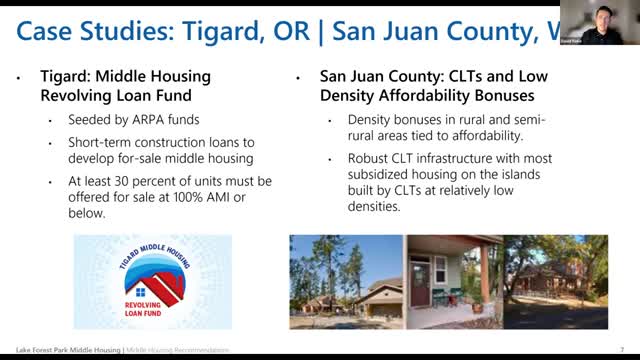Lake Forest Park explores affordable housing options with community land trusts
March 13, 2025 | Lake Forest Park, King County, Washington
Thanks to Scribe from Workplace AI , all articles about Washington are free for you to enjoy throughout 2025!

This article was created by AI using a video recording of the meeting. It summarizes the key points discussed, but for full details and context, please refer to the video of the full meeting. Link to Full Meeting
The session began with a presentation highlighting the role of Community Land Trusts (CLTs) in providing subsidized housing, particularly in the islands. It was noted that most recent affordable housing developments have taken the form of smaller cluster developments, such as duplexes and triplexes, rather than traditional low-income apartments. The county has also initiated an affordable housing fund to support these projects in collaboration with local CLTs.
As the discussion progressed, participants raised questions about the definition of affordability in housing. One member inquired whether cottage housing developments, which are typically smaller and less expensive, should be classified as affordable housing. The conversation shifted to the distinction between "big A" (income-restricted) and "little a" (generally lower-cost) affordable housing, emphasizing the need for clarity in how these terms are used in planning discussions.
Commissioners debated the merits of incentivizing density versus diversity in housing sizes. One member expressed concern that increasing density alone might not lead to more affordable options, as it could result in larger, more expensive homes being built. The importance of maintaining a variety of housing sizes to cater to different needs was emphasized, with several members sharing personal experiences of struggling to find smaller homes in the community.
The meeting also touched on the economic implications of land value in relation to housing density. It was suggested that maximizing the number of units on a given piece of land could reduce the overall cost per unit, potentially making housing more affordable. However, there was a consensus that simply increasing density without considering the size and type of housing could lead to unintended consequences, such as the proliferation of larger, more expensive homes.
In conclusion, the Planning Commission's discussions underscored the complexity of addressing housing affordability in Lake Forest Park. The need for a balanced approach that encourages both density and diversity in housing types was recognized as essential for meeting the community's varied needs. The commission plans to continue exploring these issues in future meetings, seeking to develop strategies that effectively address the housing challenges faced by residents.
Converted from March 11, 2025 Planning Commission Meeting meeting on March 13, 2025
Link to Full Meeting
Comments
View full meeting
This article is based on a recent meeting—watch the full video and explore the complete transcript for deeper insights into the discussion.
View full meeting